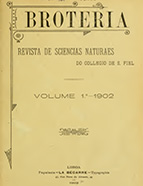

................................
The strength of the botanical and zoological studies undertaken and published by the Jesuit founders of Brotéria —Joaquim da Silva Tavares (1866–1931), Cândido de Azevedo Mendes (1874–1943), and Carlos Zimmermann (1871–1950)—was widely recognised in both national and international academic circles. This was also reflected in the increased exchanges with other journals, which began to intensify from the 1904 issue onwards.
Published annually until 1906, the small domestic market for a specialised scientific journal soon became a major obstacle to the publication’s financial sustainability. To address this challenge, the journal underwent its first major reformulation in 1907, which sought to maintain its scientific integrity while ensuring its continued publication. The solution was to organise the journal into three autonomous series under the same title, categorised as follows: Botanical, zoological and scientific publications. The first two series retained their specialisation, while the third took on a more diversified focus, covering areas such as physics, chemistry, and microbiology, and later expanding to include fields like the history of science, sociology, and archaeology. The goal of the Scientific Vulgarisation Series (SVC) was to engage a broader audience, thus supporting the continuation of the various series. This series was published bimonthly, with six issues per year. This tripartite structure remained in place until 1932, when, following the death of Joaquim da Silva Tavares—one of the founders and the first director of the three series—the Botany and Zoology series were merged into a single series, now titled Brotéria – Ciências Naturais [ Brotéria –Natural Sciences]. The series was directed by Afonso Luisier (1872–1957) from 1932 to 1956, followed by José Guedes de Albuquerque Vilhena Carvalhais (1912–2008) from 1957 to 1961. Under the leadership of Luís Jorge Peixoto Archer (1926–2011), the series was renamed Brotéria–Genética [ Brotéria –Genetics] in 1980, continuing until its extinction in 2002. Before that, in 1925, the SVC—from then on often referred to by the generic title "cultural series”—was renamed Fé-Ciências-Letras [Faith-Sciences-Literature], becoming the second series and restarting the issue numbering. These issues were now published monthly and collected into two annual volumes. This subtitle was gradually amended over the years. In 1932, it was presented as Revista Contemporânea de Cultura [Contemporary Journal of Culture]; from 1965, it became Revista de Cultura [Journal of Culture], a name it kept until 1970, when it was changed to Cultura e Informação [Culture and Information]. In 1999, it reverted to Revista de Cultura [Journal of Culture]. The last change occurred in 2001, when the subtitle Cristianismo e Cultura [Christianity and Culture] was adopted. The consistent reference to "culture" signals the broad scope of Brotéria 's thematic focus and its connection to its original mission: to establish an active presence for the Jesuits and, more broadly, for Catholicism in the cultural debates that have shaped Portuguese society over the past century. It was, in fact, as a "general culture journal" that António Leite envisioned the "transformation" that took place in 1925, as outlined in his "Preliminary Note" to the indexes of Brotéria– Revista Contemporânea de Cultura 1925-1962. On the occasion of the centenary, the then director, Hermínio Rico, described a continuity of purpose that would unify the journal's editorial direction as a "space for structured dialogue and fruitful encounters" between "Faith, Science, and Culture."
This work is financed by national funds through FCT - Foundation for Science and Technology, I.P, in the scope of the projects UIDB/04311/2020 and UIDP/04311/2020.
